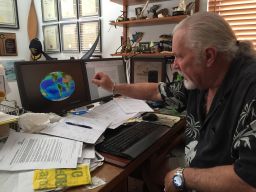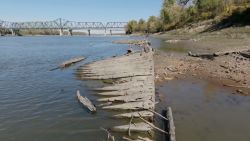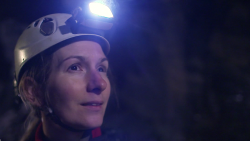Editor’s Note: John D. Sutter is a columnist for CNN Opinion who focuses on climate change and social justice. Follow him on Snapchat, Facebook and e-mail.
Dan Kipnis – a retired fishing captain on Miami Beach – has a home office so cluttered with sea creatures that it feels like a drained aquarium.
There’s a dead salmon stuck to the wall, a marlin above the bookshelf.
A taxidermic bat ray dangles from a string.
There was something freakishly ironic about sitting in this environment – an ocean waiting for water – while Kipnis told me how scientists expect his home to flood.
Kipnis pulled up a map of South Florida on his computer and clicked a button to show what happens if the seas rise by two feet, which is just a third of what the National Oceanic and Atmospheric Administration says could happen by the end of the century.
“Look at Miami Beach! Right here!” he said, pointing at the screen.
“It’s underwater!”
The green land had been displaced with blue.
That should shock exactly no one. Scientists have known for years that humans are warming the Earth by pumping carbon out of the ground and into the atmosphere – and they’ve long known that one dramatic consequence of this is that sea levels are going up and up.
Globally, sea levels rose faster last century than in any century in the previous 2,700 years. The mean tide near Miami Beach, a smaller island municipality off the coast of the South Florida mega-city, has risen 4.2 inches since 1996. Flooding already is common. Miami Beach has pledged $400 million in recent years to trying to mitigate the disaster – including installing water pumps. They’ve also been raising street levels. The city’s mayor, in particular, has made an issue of pushing floodwaters back, going so far as to shoot a campaign video that (jokingly?) features him paddling down waterlogged streets instead of driving.
But Kipnis is taking the science of global warming to heart in a way that relatively few of us do, even in a “ground zero” location for climate change such as Miami Beach.
When I met him last week, he was packing up the white, two-story house, near the center of the island, about a 10-minute walk to shore, and planning to put it on the market.
He, the wife and the sea creatures are moving to higher ground.

“The house is quite valuable right now on Miami Beach and I want to protect my investment,” Kipnis told me, adding that he expects flood insurance, already high, to become astronomical.
“It will flood here,” he added. “The house will go away.”
He wants to get his money out decades before that happens.
Kipnis is not the same kind of “climate refugee” I’ve met reporting elsewhere for CNN. In the Marshall Islands, for instance, extremely poor people are grappling with the idea that their entire low-lying island nation may not exist by the time their children are grown. I met a handful of people who saved up to buy one-way tickets to Arkansas because of the rising tides. The 65-year-old ex-fishing captain, meanwhile, stands to profit from this move. He’s well aware of this privileged position in Miami, where many people who live in the lowest-lying areas, far lower than his house in central Miami Beach, have fewer means to adapt.
Related: You’re making this island disappear
But there are two things that amaze and impress me about Kipnis’s decision. (He makes it begrudgingly, by the way, realizing he’ll never have a 10-minute walk to the beach again – he wants to live at least 20 or 25 feet above sea level – and knowing that he’s leaving the community where he grew up and where his friends and family all live.)
One is that he’s so hyper-aware of what’s happening. Climate change happens globally and over the course of many decades. It’s therefore difficult for any one person to observe. But Kipnis, who used to commute by boat to high school, told me he noticed the tides were changing in part because he saw the sea lifting barnacles higher on the docks. His work with sport fishing clubs got him involved in environmental circles and eventually he was hearing about climate change. He learned everything he could and, in 2007, he said, joined Al Gore’s Climate Reality Project, where he got formal training in the science of sea-level rise.
This information became a weight he carried.
Like he was some sort of ponytail-wearing prophet of doom.
“I know so much science that I’m actually depressed by what I’m seeing,” he told me. “I’m shell-shocked by our inability to address even the simplest parts of this.”
But here’s the second thing I find impressive: Kipnis is doing something with this knowledge.
That’s more than most of us can say.
It started with his neighbors.
Kipnis gives presentations to local Rotary clubs and schools, hoping to convince people that we must dodge the “slow-moving bullet” that is climate change. He tells them we must support policies that curb our use of fossil fuels, and that we must prepare for a warmer future. He shows them those maps of South Florida to make the point clear.
And, recently, he took this awareness campaign national.
Earlier this month, Kipnis, who also goes by “Captain Dan,” bought ski pants, snow boots and a winter coat for a trip to New Hampshire, hoping to get the attention of U.S. presidential candidates, particularly the Republicans, many of whom doubt the reality of climate science (97% of climate scientists agree we’re warming the atmosphere by burning fossil fuels and chopping down rainforests) and the rest of whom don’t want to do much about it.
The New Hampshire trip was paid for by ClimateTruth.org, a nonprofit trying to bring voices of people from the front lines of climate change into the political discourse.
But for Kipnis, the mission was personal. He was particularly determined to ask a question of U.S. Sen. Marco Rubio, the establishment Republican who’s from South Florida.
He went to three town hall meetings before he got the chance.
“I have a problem in Miami Beach, which you know about,” Kipnis told Rubio. “I’m walking around in sea-level rise. The tide’s coming up, and I’m walking in it.”
“We have a responsibility, in my mind, to these young kids,” he continued, motioning to other people in the room. “What would you do in the future, when you are the most important person in the world, to guarantee the future, with climate change, for these young people?”
Rubio’s answer: not much.
The senator did tell Kipnis that he supports mitigating the changes, meaning building new water pumps on Miami Beach, hoping to slurp away the floodwaters. But he decried the very solutions that are needed, such as a system to put a price on carbon pollution.
“Here’s what we cannot do,” Rubio said. “We cannot pass policies that will do nothing for the environment but will destroy our economy.” That’s nonsense, as anyone paying attention realizes. Solar now employs more people in the United States than the oil and gas industries. And the reality is that the costs of doing nothing about climate change – an estimated $1 trillion per year for coastal cities if they don’t adapt, to name just one example – far exceed those of pricing carbon and switching to cleaner energy sources.
But I don’t think Rubio’s non-answer was as important as Kipnis’s question.
People finally are starting to grapple with the harsh realities of climate change, with the floods and drought and super storms and waves of extinction we’re bequeathing to future generations. And I’d like to think someone who not only accepts those realities but who is willing to do something about them would end up holding America’s highest office. I resist partisanship, but, currently, those candidates are only the Democrats: Bernie Sanders and Hillary Clinton.
The Associated Press recently asked climate scientists to review for accuracy the public statements of presidential contenders on climate change. Sanders scored 87 of 100; Clinton, 94. The current GOP candidates flunked, with Rubio earning 21 of 100 points, Donald Trump 15 and Ted Cruz 6.
People like Kipnis are taking notice, and will vote on this issue. According to the Yale Program on Climate Change Communication, 36% of voters are much or somewhat more likely to vote for a candidate who “strongly supports taking action to reduce global warming.” Only 16% would be much or somewhat less likely to vote for that type of candidate.
The Republicans will gather again on Thursday for a debate broadcast on CNN. I hope that moderators take a tip from Kipnis and use this important chance to press the candidates on their plans for climate change. This is the most far-reaching issue of our time.
The next U.S. president could strengthen international climate negotiations, as outlined in December’s Paris Agreement, or could work to shred those. The next president could embrace the Clean Power Plan, which is the main U.S. policy to curb emissions, or could stall and weaken it. “It’s hard to overstate the importance of who is in the White House when it comes to dealing with climate change,” said Vicki Arroyo, executive director of the Georgetown Climate Center. This is the presidential election that “will matter for 10,000 years,” Vox’s David Roberts wrote.
It truly will matter for generations or millennia.
“How old are you,” Kipnis asked me before we left his home office.
“33.”
“You’re in for a s*** ride, you know that?”
Not if we wake up.
Add John D. Sutter on Snapchat
Subscribe to Sutter’s newsletter
This story has been updated with details about Miami Beach’s investment in infrastructure designed to hold back rising seas.




















